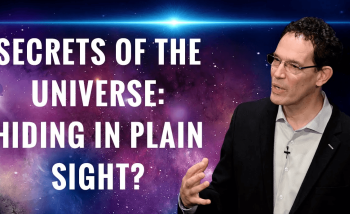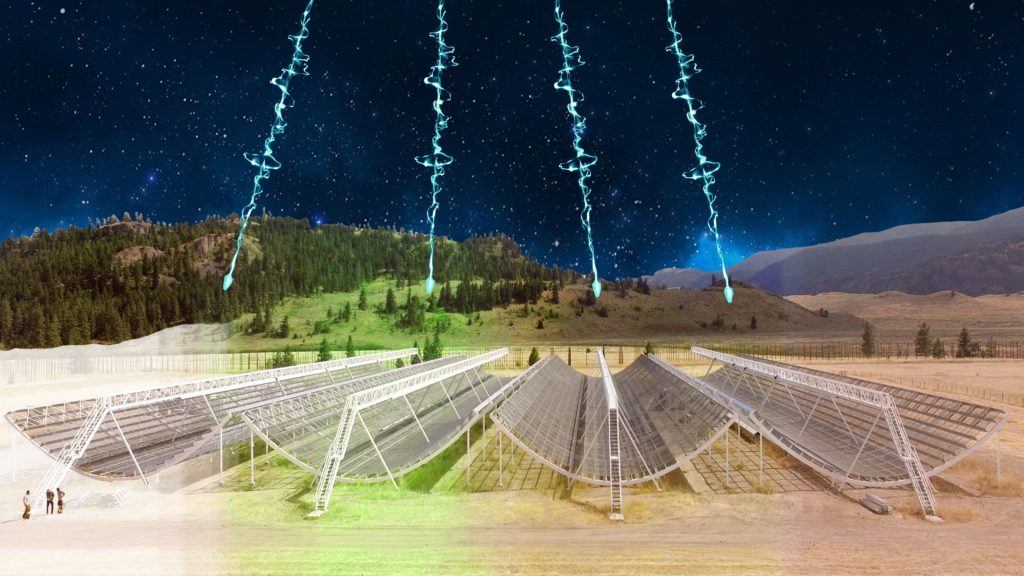By Meaghan MacSween, Dunlap Institute for Astronomy and Astrophysics, University of Toronto
Astronomers in the Canadian-led CHIME/FRB Collaboration have doubled the number of known repeating sources of mysterious flashes of radio waves, known as fast radio bursts (FRBs), through the discovery of 25 new repeating FRBs.
FRBs are considered one of the biggest mysteries in astronomy, but their exact origins are unknown. Astronomers do know that they come from far outside of our Milky Way, and are likely produced by the cinders left behind after stars die. Most of the thousands of FRBs that astronomers have discovered to date have only ever been seen to burst once, but there is a small subset that have been seen to burst multiple times.
One of the big questions is whether the repeating FRBs and those that don’t repeat have similar origins. Previous results from the CHIME/FRB Collaboration have suggested that the two populations have different characteristics, such as the durations of the bursts they produce, and the range of frequencies emitted. One possible explanation for these differences is that there are two distinct categories of FRBs: repeaters, and one-offs, with different origins.
Finding more repeating sources is key to answering this question. In new research published today in The Astrophysical Journal, the CHIME/FRB Collaboration presents 25 new sources. While they had previously established repeating FRBs as a class of sources, this is the first time they have combed through the data to find every repeating source detected so far, including the less obvious ones. To make this happen, the team developed a new set of statistics tools.
“We can now accurately calculate the probability that two or more bursts coming from similar locations are not just a coincidence,” explains Ziggy Pleunis, a Dunlap Postdoctoral Fellow at the Dunlap Institute for Astronomy and Astrophysics and corresponding author of the publication.
“These new tools were essential for this study, and will also be very useful for similar research going forward.”
In recent years, the number of detected FRBs has grown from a few dozen to thousands, thanks to radio telescopes like the Canadian Hydrogen Intensity Mapping Experiment (CHIME), which can scan the entire northern sky every day.
That capability is underpinned by ingenious software design and algorithms pioneered by Kendrick Smith, the Daniel Family James Peebles Chair in Theoretical Physics at Perimeter. As it scans the sky, CHIME is able to sift through a torrent of data in real time to pick out the brief radio flashes.
In their new research, the CHIME/FRB Collaboration has demonstrated that many repeating FRBs are surprisingly inactive, producing less than one burst per week of observing time.
“It’s possible that bursts we once viewed as one-offs are actually repeating FRBs and we just haven’t seen a second burst from them due to their low repeat rates,” says Smith.
Repeating sources of FRBs are uniquely valuable to astronomers. First, knowing that a source is a repeater creates an opportunity to observe that same source with other telescopes in more detail. More bursts also give us more information on the diversity of emission that a source can produce.
“It is exciting that CHIME/FRB saw multiple flashes from the same locations, as this allows for the detailed investigation of their nature,” says Adaeze Ibik, a PhD student in the David A. Dunlap Department for Astronomy and Astrophysics at the University of Toronto, who has led the search for the galaxies in which some of the newly identified repeating FRBs are embedded.
“We were able to hone in on some of these repeating sources and have already identified likely associated galaxies for two of them.”
Pleunis notes that this new discovery brings us closer to understanding what FRBs are. While that is exciting in itself, he says there are even further-reaching implications.
“FRBs are likely produced by the leftovers from explosive stellar deaths,” Pleunis says. “By studying repeating FRB sources in detail, we can study the environments that these explosions occur in and understand better the end stages of a star’s life. We can also learn more about the material that’s being expelled before and during the star’s demise, which is then returned to the galaxies that the FRBs live in.”
“Our understanding of FRBs has come a long way in a very short period of time,” adds Smith. “And we’re just getting started. The upcoming addition of outrigger telescopes in California and West Virginia will increase CHIME’s resolution and provide more tools in our quest to solve the FRB mystery.”
À propos de l’IP
L'Institut Périmètre est le plus grand centre de recherche en physique théorique au monde. Fondé en 1999, cet institut indépendant vise à favoriser les percées dans la compréhension fondamentale de notre univers, des plus infimes particules au cosmos tout entier. Les recherches effectuées à l’Institut Périmètre reposent sur l'idée que la science fondamentale fait progresser le savoir humain et catalyse l'innovation, et que la physique théorique d'aujourd'hui est la technologie de demain. Situé dans la région de Waterloo, cet établissement sans but lucratif met de l'avant un partenariat public-privé unique en son genre avec entre autres les gouvernements de l'Ontario et du Canada. Il facilite la recherche de pointe, forme la prochaine génération de pionniers de la science et communique le pouvoir de la physique grâce à des programmes primés d'éducation et de vulgarisation.
Ceci pourrait vous intéresser



